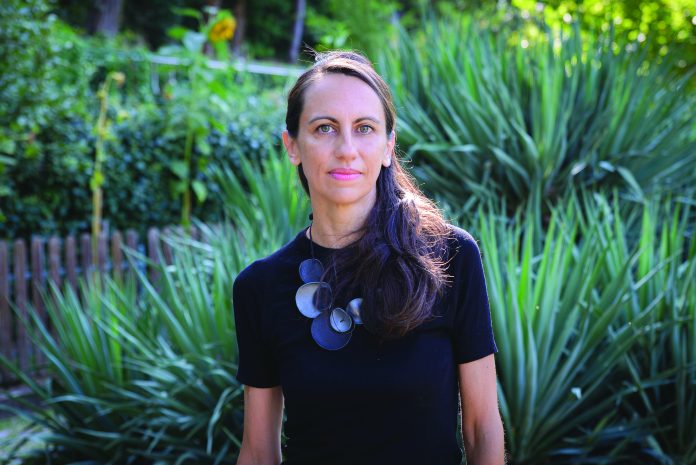by Edward Hunt
Every Saturday we’re spotlighting remarkable local females who could change the way we look at the world. This Saturday is professor Cinzia Chiandetti’s turn for whom the path to studying animal psychology began not in a laboratory, but in her grandparents’ courtyard.
As a child, she watched the chickens there, captivated by their peculiar behavior—specifically, the way they would inspect objects by turning their heads far to one side, pausing, then moving their heads to the other side. “I was curious about why they did that,” she recalls. “I knew it had something to do with their field of vision, but the precision and deliberation of the movement intrigued me.” Another memory stuck with her: her uncle’s pet Indian Blackbird, which was a master of mimicry, performing Italian songs. But it only sang some, not others, leaving her fascinated by its selection process. “Why did it choose certain tunes to mimic? What was it about those particular sounds?”
These childhood curiosities grew into a lifelong passion for animal psychology, a field Chiandetti now leads as head of the Laboratory of Animal Cognition (L.A.C.) at Trieste University’s life sciences department. Her research lies at the intersection of psychobiology, biomedical research, and ecological biology, which she refers to as the department’s “three souls.” At the heart of her work is the psychological evolution of animals—understanding how creatures, including humans, have mentally developed to adapt to the world around them.

“All creatures face the same basic challenges—finding food, avoiding predators, and surviving their environments,” explains Chiandetti. “But the way they navigate these problems and how their minds have evolved to cope can differ dramatically depending on their species and habitat.” Her research asks a fundamental question: Do different animals share common mental strategies for survival, or have their minds evolved in diverse ways tailored to their specific needs?
This investigation has led her to focus on a range of animals, from chickens to beetles. One of her current projects involves studying isopods—small, often overlooked creatures that play a crucial role in ecosystems. “They may seem insignificant,” she says, “but these tiny organisms are vital to agriculture, helping to break down organic material and support plant growth. If we disrupt their behavior, it could have unforeseen consequences for the ecosystems they help maintain.” In recent years, attention has turned to the plight of bees and their importance in pollination, but Chiandetti argues that smaller, less glamorous creatures like beetles and isopods also deserve our attention. “Understanding how these animals perceive and interact with their environment is key to better environmental management,” she asserts.
While much of her research may seem theoretical, the implications are practical. In agriculture, for instance, small acts of carelessness could impact the delicate balance of ecosystems. “It’s all connected,” she emphasizes, drawing a parallel to the growing concern over declining bee populations. “Small organisms play a part in a larger chain, and we need to understand their cognition to avoid damaging fragile systems.”
For Chiandetti, however, her primary focus always circles back to chicks. Raised in the controlled environments of the animal house in Basovizza, these birds have become central to her research. Chiandetti’s work here overlaps with her childhood memories of her uncle’s pet bird and its musical mimicry. While humans’ musical tastes are largely shaped by culture and early exposure, animals, she notes, are less tied to particular forms. “They seem to enjoy or dislike certain sounds based on frequency and harmony, rather than familiarity.”
Her research has shown that chicks are particularly drawn to consonant music, likely because it resembles the consonant vocalizations they produce. “They also make dissonant calls when they’re alone or distressed—what we call contact calls—when they’re trying to find their flock,” she explains. This led her to consider whether animals’ musical preferences might be linked to evolutionary survival mechanisms.
“At first glance, it seems obvious—chickens prefer sounds similar to their own vocalizations, just as human babies prefer their mother’s voice,” Chiandetti says. “But I believe the explanation goes deeper.” Much like the chickens’ deliberate head movements while inspecting an object, she hypothesizes that the modulation, rhythm, and frequency of sounds are crucial to their situational awareness. “Their brains process visual information from both eyes separately, comparing it before making a decision, much like humans and other bilateral organisms,” she notes. “Similarly, they might be using sound to assess their surroundings.”
Chiandetti’s findings extend to the broader question of how animals understand the world around them. “The blackbird’s ability to mimic certain songs but not others suggests an engagement with the world that goes beyond simple imitation,” she says. “It’s possible that music acts as a signal—singing might mean ‘all is well,’ while certain discordant sounds could signify danger.”
Her work has caught the attention of the scientific community and beyond. This year, Chiandetti plans to publish much of her latest research, hoping to bring more public attention to these fascinating insights. “I’d like to see more of this work available in the public sphere,” she says, “particularly for students and young people who may find inspiration in it.” To that end, her team is collaborating with local bio-artists to create interactive exhibits that showcase the research process and its findings.
As the importance of understanding natural systems becomes ever more critical in the face of environmental challenges, Chiandetti’s work is increasingly relevant. “Even in agriculture, identifying stress in chickens to improve their welfare has tangible benefits,” she says. But her work also touches on the cutting edge of artificial intelligence, exploring how non-human entities learn and interact with the world.
“We have much to learn from the humble chick,” Chiandetti concludes. “By studying how animals think and perceive, we gain a deeper understanding not just of them, but of ourselves.”





























